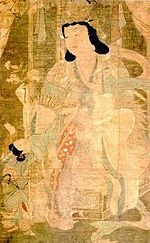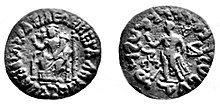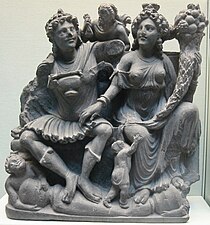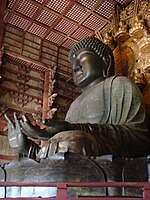Hariti
Hārītī(Sanskrit), also known asChinese:Quỷ tử mẫu ( thần );pinyin:Guǐzǐmǔ(shén),Japanese:Quỷ tử mẫu thần,romanized:Kishimojin,is both a reveredgoddessanddemon,depending on the Buddhist tradition. She is one of theTwenty-Four Protective Deitiesof Mahayana Buddhism.
| Translations of Hārītī | |
|---|---|
| Sanskrit | Hārītī |
| Chinese | Quỷ tử mẫu or quỷ tử mẫu thần (Pinyin:Guǐzǐmǔ or Guǐzǐmǔshén) |
| Japanese | Quỷ tử mẫu thần (Rōmaji:Kishimojin) |
| Korean | 귀자모신 Quỷ tử mẫu thần (RR:Gwijamoshin) |
| Tagalog | Haliti |
| Glossary of Buddhism | |

In her positive aspects, she is regarded for the protection of children, easy delivery and happy child rearing, while her negative aspects include the belief of her terror towards irresponsible parents and unruly children.
In both Chinese and Japanese Buddhism, she is venerated as aprotector deity,but in many folk traditions is often recognized as a femaledemonof misery and unhappiness towards children and parents.
Iconography
[edit]The iconography of Hārītī shows similarities to the Greek goddessTycheand may have been transmitted to East Asia through the influence ofGreco-Buddhism.InGreek art,Tyche was depicted in the presence of children, carrying acornucopia(horn of plenty), anemblematicgubernaculum(ship's rudder), and thewheel of fortune;she may stand on the wheel, presiding over the entire circle of fate.[1]


| Hariti statues from Gandhara |
|
In Chinese Buddhism, Hārītī is also known as Hēlìdì ( kha lợi đế ) or Hēlìdìmǔ ( kha lê đế mẫu ). In Chinese tradition, she is one of theTwenty-Four Protective Devas( nhị thập tứ chư thiên Èrshísì zhūtiān), a group ofDharmapalaswho are venerated as protectors of Buddhists and the Dharma.[3]Statues of this group (and Hārītī) are often enshrined within theMahavira Hallin Chinese temples and monasteries.[4] Hārītī is a figure of the 26th chapter of theLotus Sutra,and is especially important toNichiren Buddhism.InShingon Buddhism,she is named Karitei(Kha lợi đế)or Karitei-mo(Kha lê đế mẫu).Her iconography is based mostly on theDai Yakusha Nyo Kangimo Narahini Aishi Jōjuhō(Đại dược xoa nữ 歓 hỉ mẫu tịnh ái tử thành tựu pháp).[5]
In Japanese tradition, Kishimojin is an aspect ofKannon,the goddess of mercy, and she bears the epithets "Bringer of Happiness"(歓 hỉ mẫu)and "Giver of Children and Easy Delivery"(Tử an quỷ tử mẫu thần).
Narrative
[edit]
According to a Thai-BurmeseThervadaoral story popular in southeast asia, Abhiriti or Hariti was ayakshaniborn inBuddhasasanaof BuddhaVesabhu.She is considered to be daughter of Mother Dhamma. Once in city of human realm, a helpless Yaksha infant was hungry and crying. None of humans was willing to get him stop because his brutal appearance. The innocent prayed to Mother Dharma. Mother Dharma looked at him with infinite compassion or mercy. From that compassion, Hariti was born. She came to the realm of earth and lactating to the hungry demon infant. When he is satisfied and stopped crying, she went to realm of Yaksha and gave the child to his guardians. The king of Yakshas was very impressed with her. He proposed her for marriage and becoming mother of all asuras/demons. She agreed with the permission ofMother Dharma.There are hundreds of stories about Hariti and her dedication to her devotee and respon for prayers. Once upon time, earth realm experienced extreme drought, lacking crops and water. Human realm was in huge chaos, in that circumstances, buddhist monks advised them to pray Hariti to help them, human n non humans started praying Kubera and Hariti. Out of mercy, Hariti with help of divine powers, rain was happened, greenery was returned and blessed the earth realm with prosperity. She created a divine jar which provide infinite Siri/Prosperity to the human realm.
Yakshas are usually live more than humans even for many kalpas. Hariti is considered as the possesser of mysterious wealth of the earth. She was steadfast inethics,mindfulness,andwisdom.Her husband was the king ofyaksha,thekubera.She had no children. Once she was dwelling in the city of rajgir where Buddha Shakyamuni was staying. In search of experience of motherhood, she started bringing unhappy human babies in her abode from Rajgir city where theBuddha Shakyamuniwas staying. Consequently, victim mothers from Rajgir pleaded to the Buddha. Buddha went to the abode of Hariti and brought one of her kidnapped beloved children with him in his vihara. Hariti was devastated when she found out. After futilely searching for that little, she finally appealed to the Buddha. The Buddha revealed how she was suffering in the absence of one child, similarly, many of other mothers and families were still suffering from the loss of their beloved children. Hariti acknowledged that their suffering is bigger than her. She returned all the kidnapped babies to their mothers and again became steadfast in the Dhamma. Buddha taught her Dhamma rituals associated with upbringing of a child. Hariti started practicing universalmettaandkarunato all beings. Hariti declared that she is no longer a woman with no children, she is now the mother of all beings. Hariti promised the Buddha that she would protect and love children of all realms. She practices and teaches the fourBrahma viharasto all worldly beings, for benefits of her children. Buddha hailed her as theJagatmataor the mother of all realms. In Theravada, she is the supreme mother of all humans as well as non humans who hari(eliminates or destroys)(-ti) obstacles from their life.
According to anotherMahayanamyth, Hārītī was originally arākṣasīofRajgirat the same time thatGautama Buddhaalso lived there. She had hundreds of children of her own, whom she loved and doted upon, but to feed them, she abducted and killed the children of others. The bereaved mothers of her victims pleaded to the Buddha to save them. So, the Buddha stole the youngest of her sons, Piṅgala (in a variant version, the youngest daughter), and hid him under his rice bowl. After having desperately searched for her missing son throughout the universe, Hārītī finally appealed to the Buddha for help.
The Buddha pointed out that she was suffering because she lost one of hundreds of children, and asked if she could imagine the suffering of parents whose only child had been devoured. She replied contritely that their suffering must be many times greater than hers. She then vowed to protect all children, and in lieu of children's flesh, she would henceforth only eat pomegranates. Henceforth Hārītī became the protector of children and women in childbirth. In exchange, the Buddha gave herbodhi,which enabled her to withstand black magic and evil powers, and gave her the facility to cure the sick.[6][5]
In the Japanese version of the tale, Kishimojin enlisted the aid of theTen Rākṣasī Women(Thập la sát nữ,jūrasetsunyo)to abduct and murder the children of other families. In some variants of the myth, the Ten Rākṣasī Women are themselves daughters (or daughters' daughters) of Kishimojin.[7]When Kishimojin accepted the Buddha's teachings, the Ten Demon Daughters did likewise.[5]
References
[edit]- ^Katsumi Tanabe,Alexander the Great: East-West Cultural Contact from Greece to Japan(Tokyo: NHK Puromōshon and Tokyo National Museum, 2003).
- ^British Museum Collection
- ^A dictionary of Chinese Buddhist terms: with Sanskrit and English equivalents and a Sanskrit-Pali index.Lewis Hodous, William Edward Soothill. London: RoutledgeCurzon. 2004.ISBN0-203-64186-8.OCLC275253538.
{{cite book}}:CS1 maint: others (link) - ^"Phật giáo nhị thập tứ chư thiên _ trung quốc phật giáo văn hóa võng".2016-03-04. Archived fromthe originalon 2016-03-04.Retrieved2021-04-27.
- ^abcSchumacher, Mark (1995),"Kariteimo",A-Z Photo Dictionary of Japanese Buddhist Statuary,onmarkproductions.com.
- ^Coulter, Charles Russell; Turner, Patricia (2000), "Kishimojin",Encyclopedia of Ancient Deities,Jefferson: McFarland, p. 272,ISBN0-7864-0317-9.
- ^Chitkara, M. G., ed. (2005), "Jurasetsu",Encyclopaedia of Buddhism,Glossary of Buddhism Terms, vol. XXI, New Delhi: APH Publishing, p. 218,ISBN81-7648-184-X.
Bibliography
[edit]- Langenberg, Amy Paris (2013).Pregnant Words: South Asian Buddhist Tales of Fertility and Child protection,History of Religions 52 (4), 340-369
- Lesbre, E. (2000).La conversion de Hārītī au Buddha: origine du thème iconographique et interprétations picturales chinoises,Arts asiatiques 55 (1), 98-119
External links
[edit] Media related toHaritiat Wikimedia Commons
Media related toHaritiat Wikimedia Commons





![Statue of seated Hārītī with children from Yusufzai in the British Museum, 2nd–3rd centuries CE[2]](https://upload.wikimedia.org/wikipedia/commons/thumb/9/90/GoddessHaririWithBaby.jpg/127px-GoddessHaririWithBaby.jpg)





